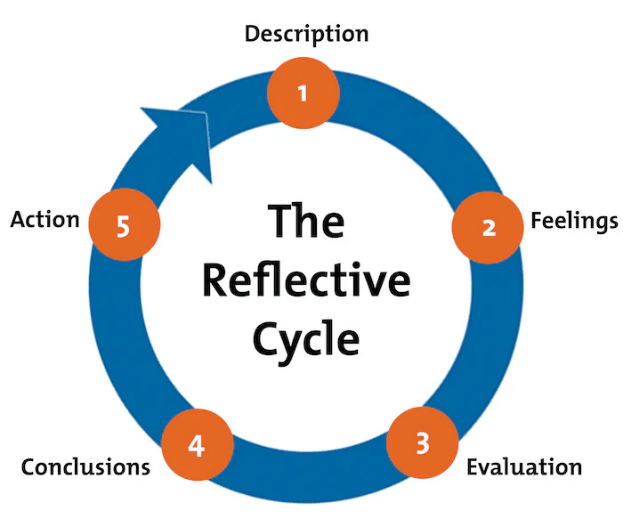Introduction
Gibbs’ Reflective Cycle is a powerful model that encourages people to think critically and systematically about their experiences, specific events, and occurrences. This approach makes it easier for them to identify the major causal factors and adjust their actions or behaviors accordingly. This model also supports the concept of lifelong learning. The purpose of this paper is to apply Gibbs framework to an incident that happened in midwifery practice.
Description of the Incident
The selected scenario for this discussion revolves around educating pregnant women about the importance of getting vitamins and iron supplements. The background of this incident is that a specific woman gave birth to a child with extremely low weight. The baby developed breathing problems and was immediately diagnosed with infant respiratory distress syndrome. This kind of medical condition occurs when an individual has immature lungs. Unfortunately, this newborn baby died two days after birth. A detailed inquiry into this happening revealed that the mother was not taking the recommended supplements during her pregnancy (Gagnon & Orellana, 2022). This example was a clear indication that many women were not taking the issue of nutrition into consideration, thereby exposing themselves and their unborn babies to numerous health challenges or risks.
Application of Gibbs’ Cycle and Discussion
Gibbs’ Reflective Cycle is an evidence-based self-reflection tool that can help people to examine their experiences and identify new measures for improving them and acquiring additional ideas (see Figure 1). This framework has become essential in the fields of nursing and healthcare delivery. It encourages people to identify both the negative and positive aspects of any given eventuality and learn from it.

Description
During the first stage, the involved individual will give a detailed description of the event without presenting any conclusions or personal insights (see Figure 1). The presented incident occurred when a newborn baby died two days later due to a respiratory condition triggered by or associated with low birth weight (Buakhai & Rithpho, 2019). Those involved provided adequate support to the baby after birth and the mother. All caregivers, practitioners, physicians, and midwives were part of the process to ensure that the child received adequate oxygen.
Feelings
As part of the team involved in the midwifery process, I was moved by this event and sympathized with both the baby and the mother. I felt traumatized since such an incident could have been controlled or prevented. This becomes a learning point for all pregnant women and every person planning to have a child. My teammates, the mother’s family members and clinicians were unhappy because of this loss. They still maintained that such an event could have been avoided.
Evaluation
This midwifery incident occurred because the targeted woman had not appreciated the importance of vitamin and iron supplements during pregnancy. However, all participants and clinicians provided adequate and timely support throughout the period. They ensured that high-quality services were available to the newborn baby. Personally, I provided adequate care and guidance to the mother after she gave birth. I also updated her family members and relatives continuously. All other stakeholders ensured that the baby got timely medical attention (Dahl et al., 2020). From this event, I have learnt that the issue of nutrition is something that all people should never ignore. Childbearing women should go further to receive adequate supplements and vitamins if they are to give birth to healthy babies (Van Lonkhuijzen et al., 2022). This knowledge will encourage me to empower, educate and sensitize more individuals about such an event and how to prevent it.
Conclusion
Although this incident resulted in the death of an innocent baby, it can become a powerful model for guiding health professionals in the field of midwifery and public health experts to educate more women about the importance of vitamin and nutrient supplements during pregnancy. In future, I will always sensitize and inform every pregnant woman about the benefits of getting the right minerals and food materials. I will have to engage in lifelong learning in an attempt to learn more about the best nutrients that are appropriate for women during pregnancy. This knowledge will make it easier for me to prevent similar events.
Action Plan
The recorded incident has become a powerful model for ensuring that more women give birth to babies with average weights. The best action plan entails the implementation of a program that educates women about the importance of taking vitamin supplements during birth. The campaign should be designed in such a way that it encourages all beneficiaries to inform their friends, neighbors, and relatives. Similar programs should be available to all women seeking prenatal health services. The introduction of evidence-based measures will prevent the reoccurrence of a similar incident.
Conclusion
The above discussion has described how Gibbs’ cycle can guide medical professionals to address most of the problems that might occur during the delivery of health services. The described incident becomes a meaningful case study for overcoming various sentinel events in midwifery. Pregnant women should receive timely guidance and take the required minerals and vitamin supplements in order to give birth to healthy babies.
References
Buakhai, P., & Rithpho, P. (2019). Reflections of positive experiences in midwifery and nursing of maternal-newborn education in Thailand: Lessons learned from Naresuan University. Journal of Health and Caring Sciences, 1(2), 110-117.
Dahl, B., Heinonen, K., & Bondas, T. (2020). From midwife-dominated to midwifery-led antenatal care: A meta-ethnography. International Journal of Environmental Research and Public Health, 17(23), 8946.
Gagnon, R. F., & Orellana, P. (2022). Humanization of birth, women’s empowerment, and midwives actions and knowledge: Experiences from Quebec and Chile. Saúde Em Debate, 46(135), 987-998.
MindTools. (n.d.). Gibbs Reflective Cycle.
Van Lonkhuijzen, R. M., Cremers, S., De Vries, J. H. M. J., Feskens, E. J. M., & Wagemakers, M. (2022). Evaluating ‘Power 4 a Healthy Pregnancy’ (P4HP)–protocol for a cluster randomized controlled trial and process evaluation to empower pregnant women towards improved diet quality. BMC Public Health, 22(1).